No Seasonal Rise in Toll Prices at HAC-operated Motorways This Summer Too
ZAGREB, 10 June 2021 - Croatia's government on Thursday decided not to increase motorway toll fares this summer after it did not apply the seasonal increase also in the summer of 2020 due to the COVID-19 pandemic.
The lower motorway toll prices will remain in force in a bid to contribute to efforts to boost the business activity in the tourism and transport sectors.
Thus, the state-run motorway operator HAC has been authorized not to apply the summer price list between 15 June and 14 September when motorway toll fares are 10% higher than out of the season.
The financial effect of this measure is estimated at HRK 77.5 million, Transport and Infrastructure Minister Oleg Butković said.SFor the latest news from Croatia, follow TCN's dedicated page.
Croatian Motorways Ready for Tourism Season with Even More Amenities
June 1, 2021 – Investments in the yearly maintenance of Croatian motorways are sizeable, but justified when compared to the revenue generated, particularly during the summer season.
Croatian motorways are a crucial part of Croatia’s tourism infrastructure. They are also a very important factor in connecting various regions of the country. The topography of Croatia often makes local roads inefficient. Year after year majority of guests coming to Croatia with cars have very positive comments on the motorway system. However, the entire thing doesn’t come cheap.
With the constant need for maintenance and updating, Hrvatske Autoceste (Croatian Motorways Ltd - HAC) is hard at work every year to prepare the infrastructure for the summer season. The surge of cars on Croatian roads will once again happen in a year, starting in June. Index.hr reports Croatian Motorways Ltd invested 404.9 million kn (around 54 million EUR) into this year’s maintenance and upgrading of the motorway system. Much of this money has been invested in rest stops along the motorways. This is one part of the investment travellers to Croatia will immediately feel. Upgrades made in rest stops are mostly in interiors, bathrooms, and operational technology. HAC also notes the emergency services are going to be reinforced.
New and Updated Services
Along with the standard 24/7 road assistance patrolling the motorways, additional contractors will provide more complex roadside and system maintenance services. Teams of emergency medical services and over thirty vehicles with automatic defibrillators will be on hand as well. Much like the majority of other businesses, HAC expects higher revenues in 2021 than the previous year. In 2020 the numbers were very low due to COVID19 pandemic restrictions. Because of this, HAC started this year with around a hundred employees less than 2020. Estimated revenue from motorway tolls in Croatia this year is 2,18 billion kn (around 290 million EUR).
For more on travel in Croatia, follow TCN's dedicated page.
1129 Brand New Traffic Cameras Coming to Croatian Motorways
March the 19th, 2021 - Over one thousand brand new traffic cameras are due to grace Croatian motorways, adding an additional deterrent to those considering speeding or reckless driving.
As Poslovni Dnevnik writes, driving in the wrong direction, pedestrians or a stopped vehicle on the road are just some of the traffic hazards about which the state-of-the-art automatic incident detection system (AID) procured by Croatian Motorways will alert HAC employees working in traffic control centres in just a few seconds, according to a report from Vecernji list.
Subsequently, additional cameras will be installed for this purpose on Croatian motorways, more specifically on the sections of the Rijeka - Zagreb and Rijeka - Rupa motorways, given that the company ARZ has been merged with HAC.
The total value of this procurement is estimated to stand at approximately 55 million kuna. The AID system detects when an incident happens and generates an alarm just a few seconds after the incident occurs, allowing the operator to do what is needed to prevent a secondary incident.
The AID triggers an audible alarm in the event, automatically displays the scene of the incident on the road to the operator and records everything happening, and the cameras also cover a minimum of three traffic lanes and one stop lane.
In addition to the incidents already mentioned, AID warns of traffic congestion, slow vehicles and any loss of normal levels of visibility. An alarm sounds in the tunnel when the loss of visibility of the cameras is detected by the appearance of smoke due to a fire having broken out somewhere nearby.
The system set to be placed along Croatian motorways can also collect data on vehicle classification, average speed, travel time, vehicle distance and more. The new traffic cameras will have a motorised varifocal lens, an IR reflector, and will have the ability to minimum 25 frames per second.
HAC has a Central Centre for the Supervision and Management of Motorway Traffic connects all regional Croatian motorway traffic control and management centres (RCNUPAC).
For the latest travel info, bookmark our main travel info article, which is updated daily.
Read the Croatian Travel Update in your language - now available in 24 languages.
Falling Snow Causes Treacherous Conditions on Croatian Roads
January 25, 2021 – Released images show falling snow is causing extremely difficult conditions on some Croatian roads, both motorways and state roads, with the mountainous regions of Lika and Gorski Kotar most affected
Any optimists living in Zagreb could be forgiven for thinking winter was over. Over a succession of two days last week they were basking in the relatively balmy daytime temperatures of 16 degrees. The sun shone brightly, the boots stayed indoors and lighter jackets were thrown on to visit the shops. Not everyone in Zagreb is an optimist, though. And those with an experience that is greater than their hope knew the reality of the situation; Croatia's winter can turn round at any moment to bite you in the ass.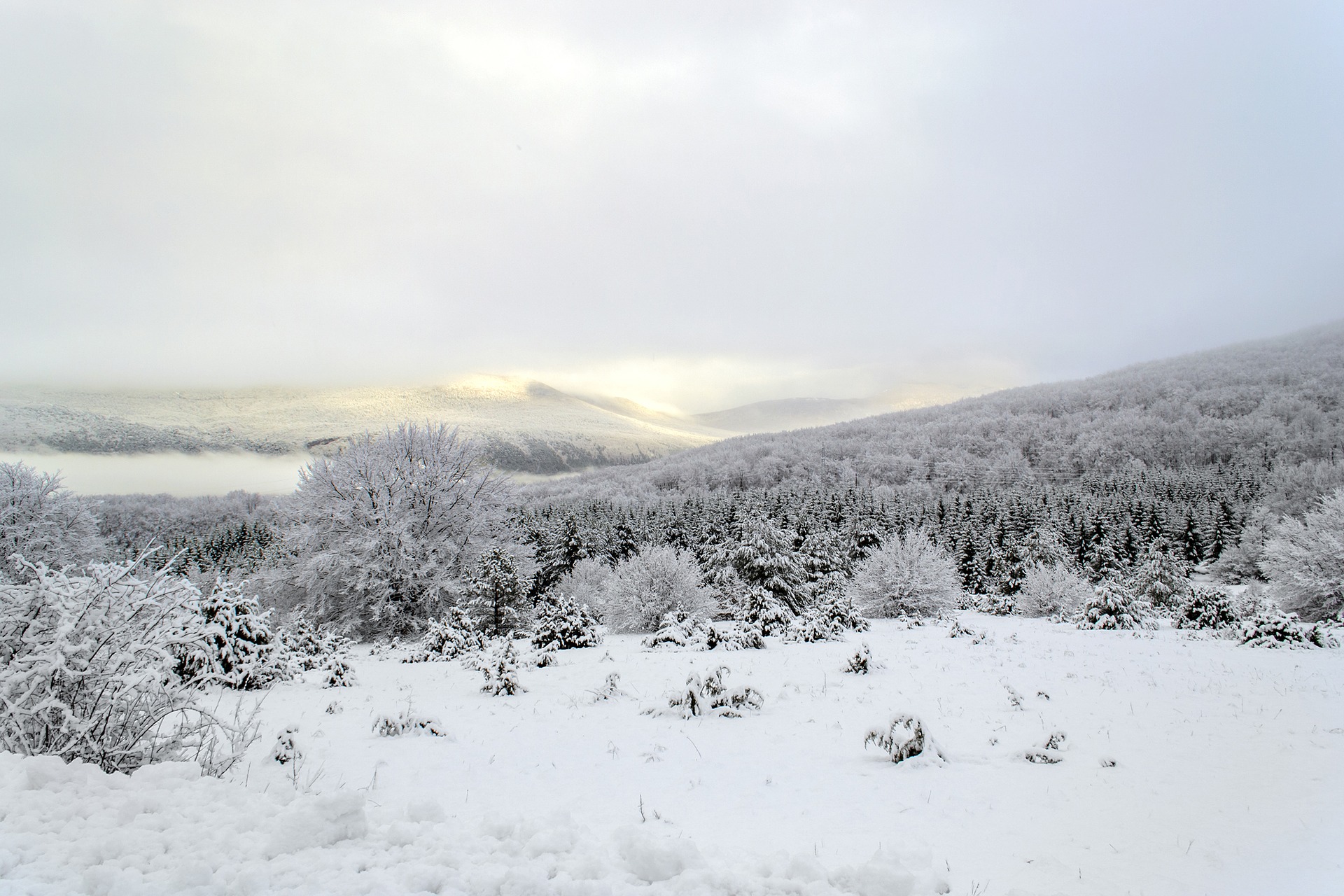 Snow covering the Lika region
Snow covering the Lika region
And that's exactly what happened this weekend, when falling snow produced treacherous driving conditions across a wide area of Croatia. On some motorways, a ban on trucks with trailers and tractors with semi-trailers is in place because of the continually falling snow. Another response to the falling snow has been to make winter vehicle equipment mandatory.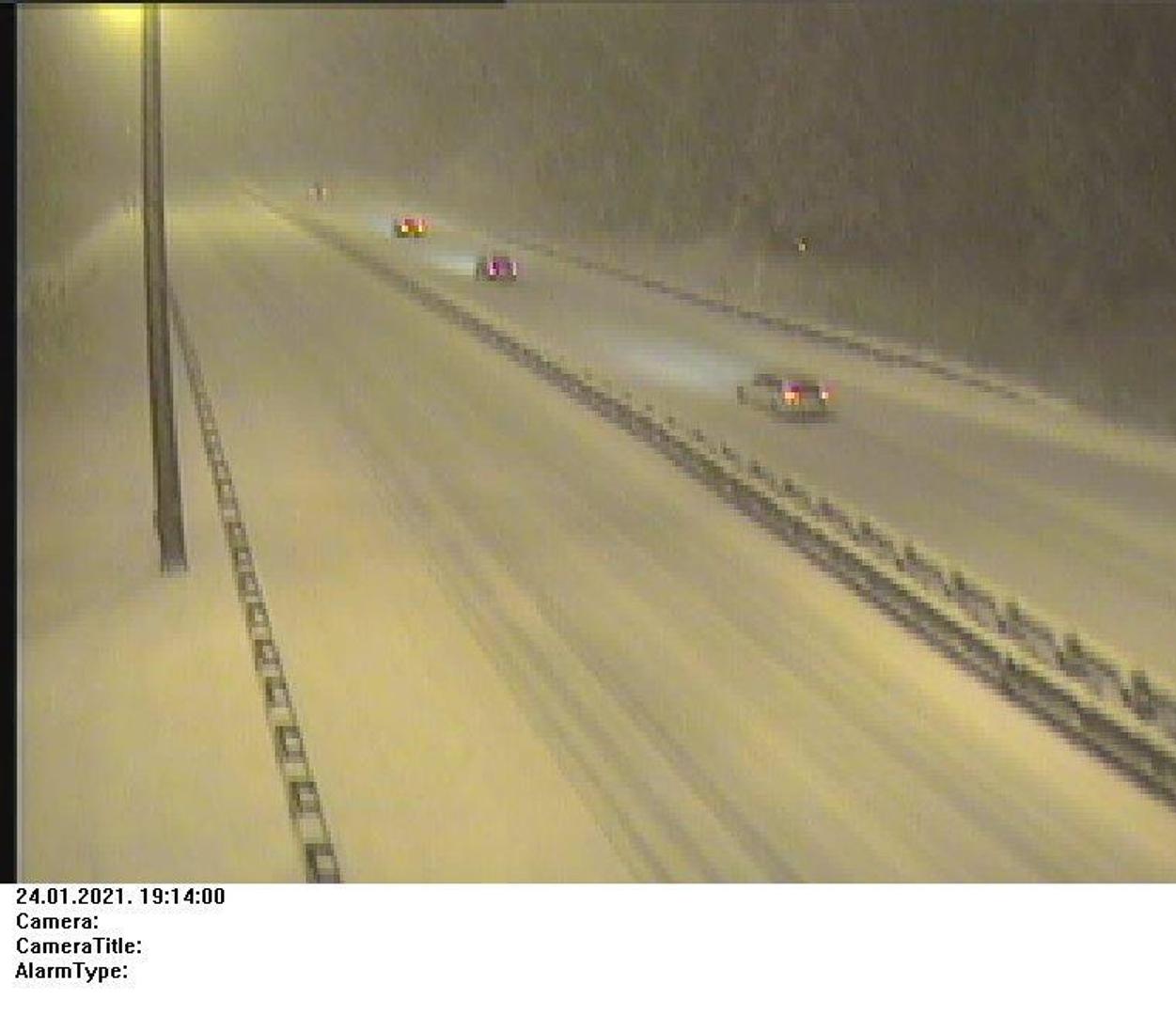 A thick layer of snow covers the road near Delnice at 19.14 on Sunday 24 January 2021 © HAK
A thick layer of snow covers the road near Delnice at 19.14 on Sunday 24 January 2021 © HAK
While the Croatian capital was experiencing its warm spell, falling snow continued to descend on more mountainous regions of the country, Lika and Gorski Kotar in particular. And it is those that remain most affected by the treacherous driving conditions. Hrvatske Autoceste (Croatian Motorways) are responding to the continuing weather conditions. But, they released pictures of one motorway section near Delnice which, even after plowing, was 30 minutes later again covered by the falling snow.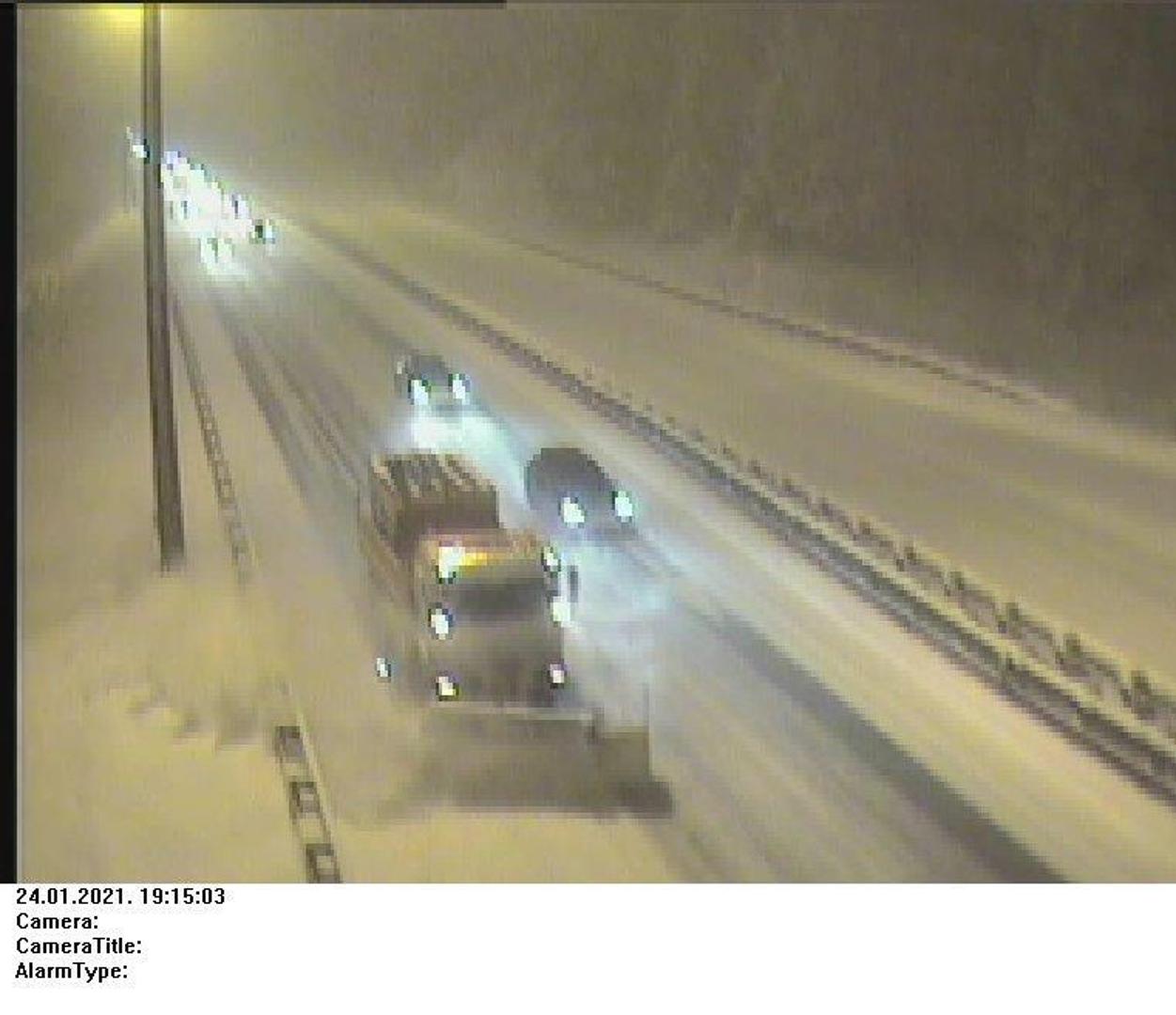 A snowplow arrives at 19.15 to clear the snow © HAK
A snowplow arrives at 19.15 to clear the snow © HAK
Thick falling snow and ice made it difficult to drive on the A6 Zagreb - Rijeka highway. The National Association of Drivers and Vehicle Owners (HAK) issued a series of warnings for the following routes: A1 Zagreb-Split-Ploče between the junctions of Bosiljevo II and Maslenica, A6 Rijeka-Zagreb between the junctions of Bosiljevo II and Kikovica, state road DC1 between Zagorje and Gračac and state road DC3 through Gorski Kotar between Zdihovo and Kikovica. By 19.45 the road is in the same state as before the snowplow arrived, because of continually falling snow © HAK
By 19.45 the road is in the same state as before the snowplow arrived, because of continually falling snow © HAK
HAK also reported that there is currently no passable road for trucks with trailers and tractors with semi-trailers from the direction of the continental interior towards Rijeka and Istria and Dalmatia and vice versa. The colder temperatures are expected to stick around for most of the early part of the week, although the skies may be clearer in some regions. Temperatures will rise again heading towards next weekend under an increasing cloud cover, but the chilly conditions might well bounce back towards the end of next weekend. Zagreb itself could even experience more snowfall at that time.
HUKA: Increased Traffic and Revenue on Croatian Motorways in 2019
ZAGREB, November 2, 2020 - The total number of vehicles on Croatian motorways in 2019 increased by 4.19% compared to 2018 while motorway toll revenue amounted to HRK 3.15 billion without VAT, which is a rise of 4.89%, the Croatian Association of Motorway Road Toll Concession Holders (HUKA) said on Monday.
The association's national report of the motorways notes that the total motorway network in Croatia at the end of 2019 covered 1,306 kilometres of motorways that were managed by four companies: Hrvatske Autoceste (HAC), Bina-Istra, Autocesta Rijeka-Zagreb (ARZ) and Autocesta Zagreb-Macelj.
The length of the network of motorways did not change in 2019.
Investments for the construction of new motorways in 2019 amounted to HRK 434.56 million while investments in the current sections amounted to HRK 389.91 million, which is a total of HRK 824.47 million. Investments of HRK 716.48 million are planned for the construction of new legs and HRK 661.06 million for already constructed sections.
The total number of vehicles on motorways in 2019 increased by 4.91% compared to 2018 or 86,660,015 vehicles with each of the companies generating an increase in turnover.
HUKA recalled that Croatia operates a closed toll system on its motorways with tolls at exit and entry points.
The report notes that last year a total of 2,697 accidents were recorded on the motorways with 31 fatalities and 459 people sustaining injuries.
The total number of accidents increased by 3.71% compared to 2018 while the number of fatalities decreased by 8.82% and there was a fall of 18.76% in the number of people injured in those traffic accidents.
(€1 = HRK 7.568318)
Croatian Motorways Goes Ahead With Zagreb-Sisak Road Completion
As Novac/Kresimir Zabec writes on the 2nd of October, 2020, back in June, Croatian Motorways (HAC) announced a preliminary consultation on the open public procurement procedure for the Novi Vinodolski bypass, and the announcement of the tender is still pending. There is also the 11 kilometres of the Zagreb-Sisak road to deal with.
''We're working on financing the construction of the Novi Vinodolski bypass with funds from the 'Competitiveness and Cohesion' EU Fund. If we succeed in that, with the funds we've earmarked for this project, we'd start the construction of the last part of the Zagreb-Sisak motorway,'' explained the President of Croatian Motorways, Boris Huzjan.
Non-refundable funds
The estimated value of the works stands at 495 million kuna. It is a 9.8 kilometre long bypass, of which 6.5 kilometres runs along the route of the future A7 motorway, and the remaining 3.3 kilometres refers to the connecting roads to the Adriatic Highway (D8). Part of the bypass, more precisely the Selce-Novi Vinodolski section, is an integral part of the future A7 Rupa-Rijeka-Zuta Lokva motorway and its position coincides with the left carriageway of this motorway.
The Zagreb-Sisak motorway was completed to Lekenik and an addition 11 kilometres to Sisak needs to be constructed. HAC obtained all the necessary project documentation as well as a building permit. The proposal of existing installations on the route is in progress and activities on land acquisition have begun. The estimated value of the construction of these 11 kilometres of motorway stands at 291 million kuna, and the planned construction period is two years.
If this were to happen, HAC would, for the first time in its history, be able to obtain an EU grant for some of its projects. Namely, the EU doesn't co-finance road projects that will be paid later. Since the Novi Vinodolski bypass will be in the profile of a semi-motorway and no toll collection is foreseen for it, the project can be nominated for co-financing from EU funds.
Recovery fund
As has since been learned unofficially, the representatives of the Ministry of Transport are intensively negotiating with the European Commission to transfer several large infrastructure projects financed from the budget of Croatian Roads and Croatian Motorways to co-financing from EU funds. The plan is to "transfer" some of the projects already nominated for funding from the Competitiveness and Cohesion Fund to the newly launched EU Recovery and Resilience Fund, which would open the possibility of co-financing some new projects from the Competitiveness and Cohesion Fund.
Until now, HAC and HC projects could not be nominated for co-financing from that fund for the period from 2014 to 2020 because there were no more funds for transport projects in it.
For the latest travel info, bookmark our main travel info article, which is updated daily.
Read the Croatian Travel Update in your language - now available in 24 languages
Continental Croatia Trains: Inland Opens Up With Green Travel
October 3, 2020 - With charter airlines in a state of flux and Croatia Railways beginning a renewal of their fleet in Slavonia, are continental Croatia trains the eco-friendly and best way to unlock the inland's amazing potential?
Everything changes. Nothing stays the same. Even before 2020 arrived, lifestyles and trends were headed in new directions. Eco-tourism and agro-tourism were two of the fastest-growing areas within the travel sector, this behaviour change a response to concerns about the environment. And nowhere in the country stands better poised to take advantage of this interest than continental Croatia.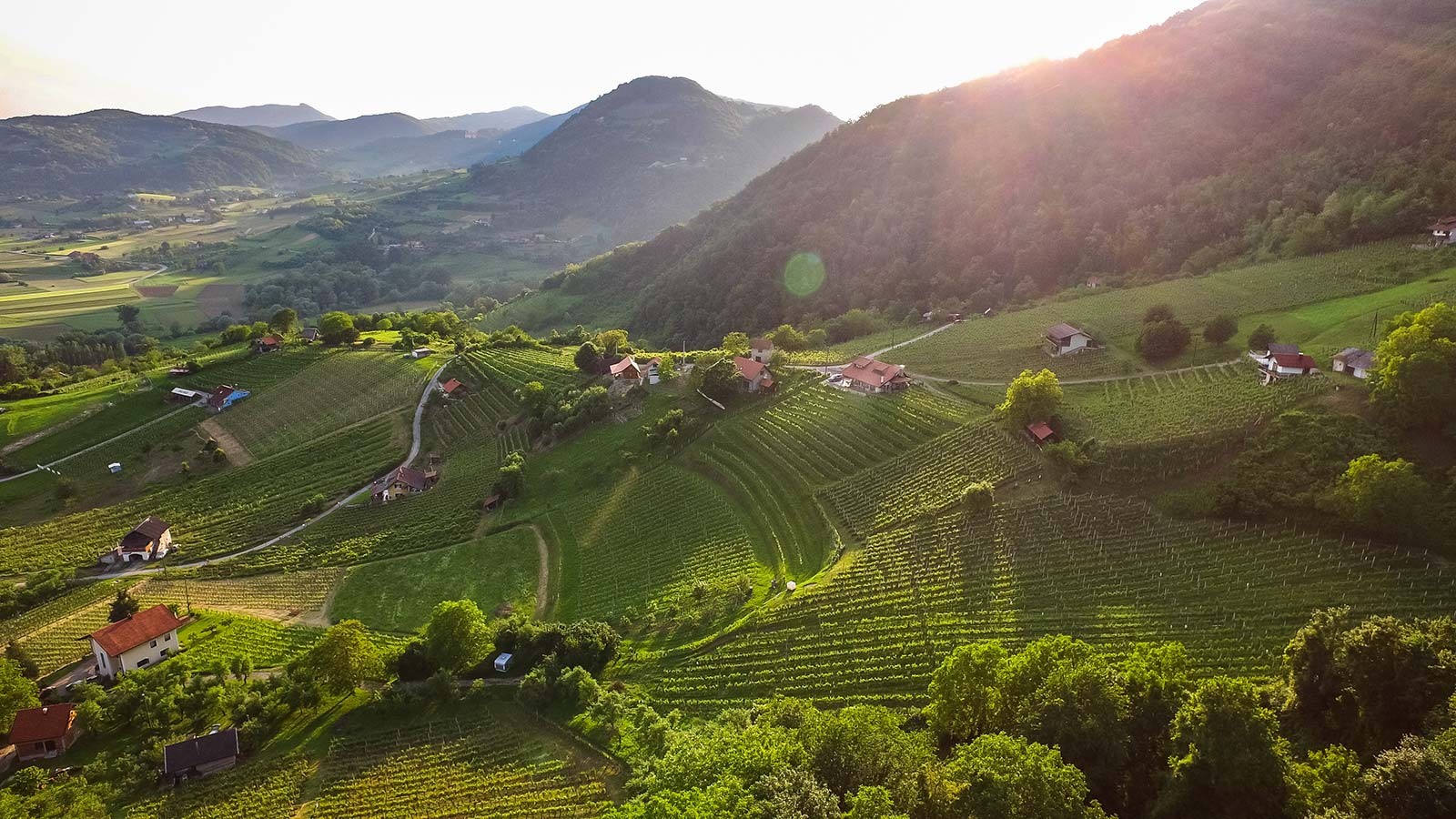 Impossibly pretty Zagorje - the region lies just north of Zagreb and is accessible by continental Croatia trains © Ivo Biocina / Croatia National Tourist Board
Impossibly pretty Zagorje - the region lies just north of Zagreb and is accessible by continental Croatia trains © Ivo Biocina / Croatia National Tourist Board
From the impossibly pretty hills of Zagorje, the peaceful rivers of Karlovac county and the hidden vineyards that surround the capital Zagreb to the vast Pannonian flatlands that stretch to Slavonia, Baranya, Vukovar-Srijem and beyond, the varied topography of continental Croatia is wild, exciting and - by many - wholly undiscovered.
This is land where agriculture and nature thrive side by side, where the stresses of modern-day existence ebb away as you readjust to a way of life that would look mostly familiar to the people who lived here centuries ago. These are places where you can truly be at one with yourself and with your surroundings. In continental Croatia, you often find yourself in an environment that is both timeless and traditional, yet wholly contemporary in regards to its ecological aspirations. And you're never far away from an exciting city environment that you can dip into on a whim – not just Zagreb, but Osijek, Slavonski Brod, Karlovac, Sisak and Varaždin too. To those who really know and love Croatia, Osijek is simply unmissable. It is both the capital of and the doorway to Slavonia and Baranya and should be more accessible by continental Croatia trains. Sadly, international transportation links to the city by air are also quite poor. Improvements in accessibility to Slavonia and Baranya by rail and road are imminent © Romulić & Stojčić
To those who really know and love Croatia, Osijek is simply unmissable. It is both the capital of and the doorway to Slavonia and Baranya and should be more accessible by continental Croatia trains. Sadly, international transportation links to the city by air are also quite poor. Improvements in accessibility to Slavonia and Baranya by rail and road are imminent © Romulić & Stojčić
Unlocking the incredible potential of continental Croatia relies on getting the message out there and facilitating travel to these regions
In recent TCN features we have detailed that motorways within Croatia are among the best in Europe - once you're inside Croatia, travelling by car (or bus) between the regions couldn't be easier. We have also seen evidence of the huge interest in travelling here by rail and using continental Croatia trains.
Of all the modern methods of long-distance travel, rail is by far the most eco-friendly. What better way to begin an environmentally friendly holiday than by arriving on continental Croatia trains? When the country wisely decided to prioritise its internal motorway system, a modern and fast inter-regional rail network was put on the back burner. Nowhere suffers greater from this decision than continental Croatia.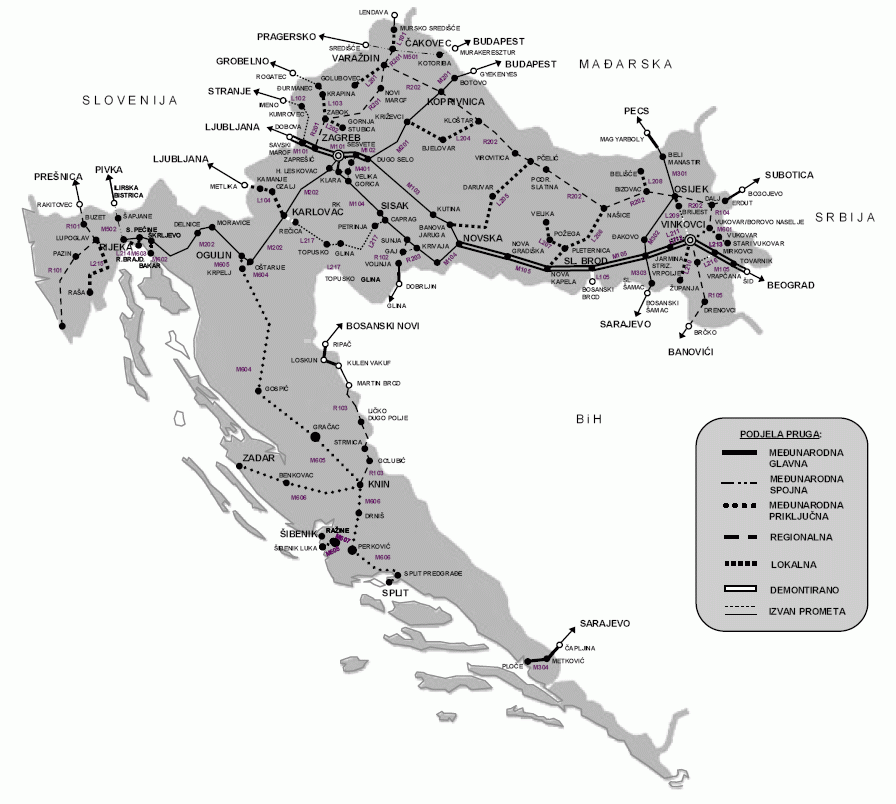 The Croatian rail network © Croatian Official Document uploaded to Wikipedia by Epepe
The Croatian rail network © Croatian Official Document uploaded to Wikipedia by Epepe
The only high-speed line that currently exists in Croatia links Rijeka to Budapest, via Zagreb and Koprivnica. Planned improvements hope to cut journey times between Zagreb and its nearest coastal city to an hour. Same as it ever was - Rijeka was the first Croatian city to be connected internationally by rail. That line also ran into the heart of Austro-Hungary and facilitated upper-class travel to places like Opatija. But does it best benefit the country to invest in more links to the coast or in continental Croatia trains? Well, the inland is not being ignored. Upgrades are being made to continental Croatia trains. This impressive beast actually services the country's coast. But would more investment in the continental Croatia trains network better service more people and help unlock the inland to tourists? Around 70% of the country's inhabitants live in continental Croatia © HŽPP
This impressive beast actually services the country's coast. But would more investment in the continental Croatia trains network better service more people and help unlock the inland to tourists? Around 70% of the country's inhabitants live in continental Croatia © HŽPP
The rail link between Zagreb and Slavonski Brod is so historic that it was once part of the four routes of the Orient Express. It has been maintained to a standard where you can make a relatively quick journey from the capital to Vinkovci via Slavonski Brod. The same cannot be said for rail travel to Osijek, the access point to Baranya and much more. So slow is the connection between Osijek and Zagreb that it has been possible over recent times to reach the Slavonian capital quicker by taking the train to Vinkovci, then the bus to Osijek, rather than travelling direct by rail.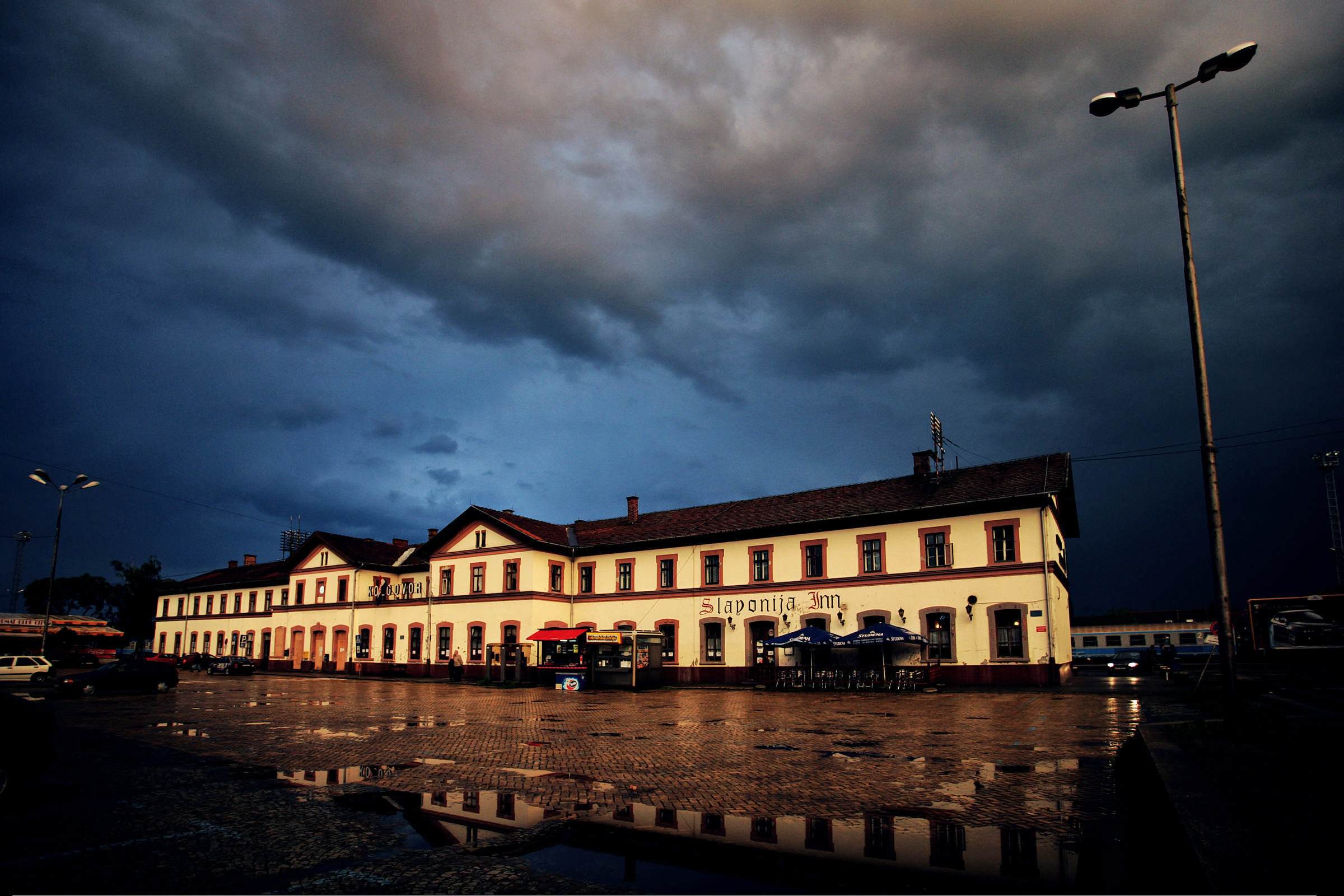 Osijek train station. A renovation to the building is planned for the near future © Romulić & Stojčić
Osijek train station. A renovation to the building is planned for the near future © Romulić & Stojčić
However, in February this year, Croatian Railways introduced four direct daily lines between Slavonski Brod and Osijek. And there will be a new tilting train line that will run between Zagreb to Osijek on Friday afternoon and from Osijek to Zagreb on Sunday afternoon, facilitating student travel. On October 15, the first low-floor train will run between Osijek and Vinkovci as an additional part of the renewal of their continental Croatia trains fleet in Slavonia. The welcome return of Croatia's second-oldest international rail line - linking Osijek to Pécs in Hungary, via Beli Manastir and Baranya - was introduced in late 2018.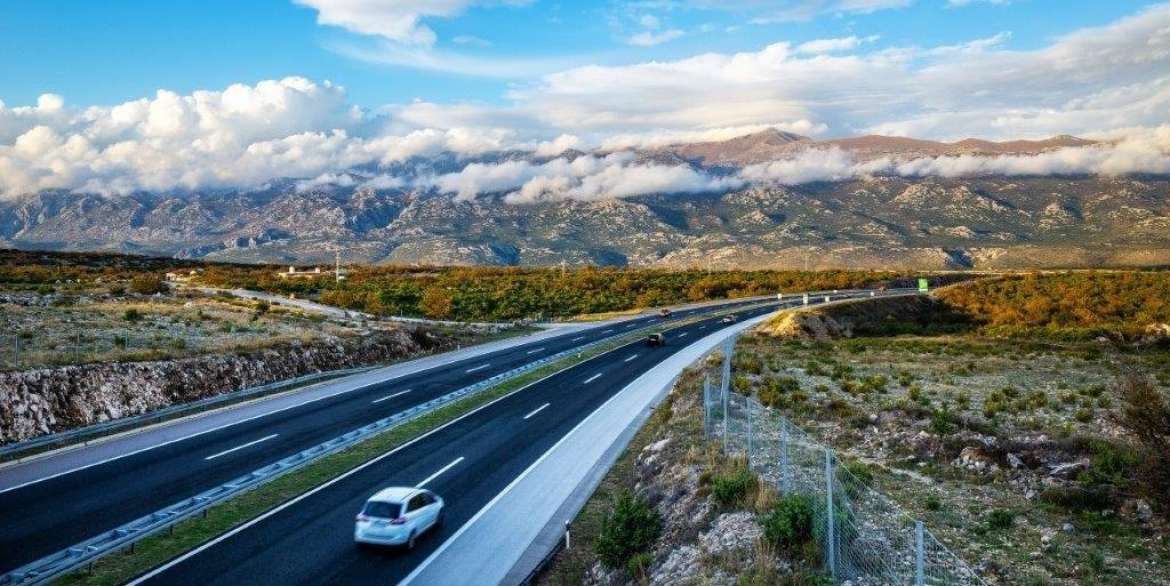 A motorway stretch between Metković and Dubrovnik, integrating the Pelješac bridge and the Croatian segment of the European corridor are the final big remaining projects in a three-decade-long undertaking to give Croatia one of the best motorway networks in Europe. Should Croatia's rail network be next? © Hrvatske Autoceste
A motorway stretch between Metković and Dubrovnik, integrating the Pelješac bridge and the Croatian segment of the European corridor are the final big remaining projects in a three-decade-long undertaking to give Croatia one of the best motorway networks in Europe. Should Croatia's rail network be next? © Hrvatske Autoceste
Access to Slavonia and Baranya will also be massively facilitated upon completion of the European corridor, which will connect North Europe to the Adriatic. Starting in Budapest, it necessitates the building of a bridge near Beli Manastir. Thereafter the motorway will pass by Osijek, connect to the Zagreb-Slavonia motorway near Lipovac, then pass through Bosnia and its capital Sarajevo and on to Ploče.
The removal of budget airline flights to the airport in Osijek remains a hindrance to attracting many international visitors to Slavonia and Baranya. However, with charter airlines facing the greatest uncertainty of all modes of transport at the current time, though their return is a must, it is perhaps now an ambition that should remain more long term. For the immediate future, improvements to rail travel look to be a brilliant way of opening up not only Slavonia, Baranya and Vukovar-Srijem, but also an eco-friendly access point capable of serving the whole of untapped continental Croatia.
For the latest travel info, bookmark our main travel info article, which is updated daily.
Read the Croatian Travel Update in your language - now available in 24 languages
Croatian Motorways Believes it Can Continue With Excellent Results
As Poslovni Dnevnik writes on the 30th of September, 2020, the obligation of Croatian motorways (Hrvatske ceste) is to take care of the entire network of state roads, which consists of more than 7200 kilometres in total. In the last four years, they have designed more than 530 kilometres of new state roads, of which 137 kilometres are city bypasses throughout Croatia, they built 116 kilometres of new roads, and reconstructed more than 405 kilometres of existing roads. In the same period, Croatian motorways was the second largest contracting authority in the Republic of Croatia.
"I'm proud to note that we've managed to improve traffic safety in the programme period in question. Namely, in 2019, we had a 13 percent increase in traffic, and as much as 12 percent fewer accidents with deaths. We have prepared and withdrawn 100 percent of the EU funds available to us from the "Competitiveness and Cohesion" Operational Programme. It goes without saying that the Ciovo bridge, which has been talked about for more than 50 years, occupies a special place here, and we finished it despite it being an almost hopeless situation. The Nin bridges which were destroyed during the great flood of 2017, were opened this year, much to the delight of all who had the opportunity to see them.
Every project in which we solve bottlenecks, especially around Split, Vodice, Rijeka or Vinkovci, are of special importance. The crown of all these projects is the historic project of building Peljesac Bridge, which we've been dreaming about for decades, listening to stories about for years, and now we're building it thanks to European Union money. This was a period in which the work of Croatian motorways was recognised through recognitions such as the "Rexpo 2018. Best New Investment Award" for the Ciovo bridge project or the Vecernji list reader award for the construction of Peljesac bridge as an economic event in 2019. These are recognitions for all of our employees for their work,'' said Josip Skoric, President of the Management Board of Croatian motorways.
What is important to emphasise is the fact that in the last four years, Croatian motorways, in cooperation with the Croatian Government, carried out the financial and operational restructuring of society and digital transformation.
"Within the project entitled The Modernisation and Restructuring of the Road Sector (MARS), a review of the company was performed and measures and activities were defined to raise efficiency. We've set clear and measurable goals and indicators through which our managers monitor every investment and every employee, and I believe that we'll further improve our business in the coming years. Furthermore, a thorough digital transformation of the company has been initiated and largely implemented over recent years. Four key areas of transformation have been defined: project management, document management, road asset management and business information systems,'' said Skoric.
''We've made great progress in the application of the so-called BIM (Building Information Modeling) technology and methodology that we implement in all phases of the construction process - planning, design, construction and maintenance. By the end of the year, we expect the procurement and selection of a contractor for the Road Property Management System (RAMS), software that will have two key functions: a reliable and accurate data inventory easy to use for roads, buildings and other road infrastructure elements and an assessment tool which will give priority and the estimation of the costs of future periodic maintenance and remediation needs, using the latest developments in international practice. I'd also like to mention that we've published the WEB GIS portal of all public roads in the Republic of Croatia on our website,'' said Skoric, adding that the completed projects are a reminder of a successful period, perhaps a motive for launching new projects, and an idea to make greater use of the development potential of transport in the Republic of Croatia.
"We still have a lot of work ahead of us, but thanks to continuous work, state roads are becoming safer and more fluid, and by building key facilities, we're significantly raising the quality of life for people. Everything done in the previous period in terms of social development and business modernisation shows I'm right when I say that we have the necessary courage and knowledge to continue with the successful results of Croatian motorways, making maximum use of EU funds, even during the pandemic,'' concluded Skoric.
For the latest travel info, bookmark our main travel info article, which is updated daily.
Read the Croatian Travel Update in your language - now available in 24 languages
Croatian Motorways Satisfied With 2020 Tourist Season Despite Woes
As Novac/Marijan Brala writes on the 10th of September, 2020, Croatian Motorways (HAC) saw 30 million vehicles in the first eight months of 2020, or 29 percent less than in the same period last year, and 1.5 billion kuna in toll fees or 31 percent less when compared to this time in 2019 were collected. As such, there is a sense of satisfaction with the shaky 2020 tourist season which managed to mitigate minuses caused by the pandemic.
"At the very beginning of the outbreak of the coronavirus epidemic in Croatia, HAC prepared a Crisis Business Plan according to the guidelines of the Ministry of State Property, which included a 35 percent reduction in toll revenues. Now, after eight months, the situation is somewhat better than that plan," they commented from HAC.
They also revealed that the largest decrease in traffic and revenue in the first eight months of this year compared to last year was recorded on the A7 Rupa-Rijeka motorway, down by 46 percent, and then by 33.6 percent on the A1 Bosiljevo-Split-Ploce motorway and from 33 percent on the highway A3 (Bregana-Zagreb-Lipovac).
The 2020 tourist season mitigated the minuses
Noting that due to the epidemic they adopted a number of measures that directly helped the economy, including the decision to not go with summer/seasonal increase in toll prices of 10 percent, HAC stated that this measure saved citizens and the economy about 33 million kuna.
"At the beginning of the 2020 tourist season in June, traffic on motorways was slightly behind last year's, by 35 percent, but in the summer season it did increase and the differences decreased. Given that last year was a record in all segments of tourism, it's difficult is to compare the numbers this year and the current situation, but in the end, we're satisfied with the 2020 tourist season, which proved that the decisive factor in choosing a holiday destination is its availability within a few hours, which is possible with modern and safe motorways in Croatia,'' they stated from HAC.
Investments are going according to plan
Despite the dire business situation caused by the ongoing epidemic, investments are going according to plan and they haven't stopped. The investments which are planned for this year are in the amount of almost 401 million kuna.
"Of these total planned investments, 196.1 million kuna is planned for construction, and almost 205 million kuna for extraordinary maintenance activities. So far, slightly more than 219.1 million kuna has been realised," they stated from HAC, adding that until the end of this year, there are still investments worth almost 182 million kuna going ahead as initially planned.
The projects in the plan are the corridor V.c - Beli Manastir-Osijek, the Novi Vinodolski bypass, asphalt rehabilitation on the A4 Zagreb-Gorixan highway and the Ranzirni kolodvor/station viaduct.
By the end of the year, the merger of ARZ with HAC will be completed
According to the plan, the process of merging ARZ (the company Autocesta Rijeka-Zagreb) with HAC is underway, which is expected to be completed by the end of this year or more specifically by December the 31st, according to the decision of the Croatian Government from May the 21st this year.
"All necessary activities are being carried out in this merger process, which is a continuation of reform and restructuring in order to achieve additional cost optimisation. Namely, further efficiency improvements are possible in regard to overhead costs, because HAC and ARZ have numerous activities that overlap significantly. These are also related to the operating costs in joint administrative functions, which would be reduced to 15 million kuna per year in the next two years,'' they emphasised from HAC.
In addition, they concluded, the merger creates the proper preconditions for more rational financial management and greater potential for investment in maintenance and construction, and the unification of state-owned motorway management should facilitate the introduction of a new toll collection system and bring savings in public procurement procedures.
For the latest travel info, bookmark our main travel info article, which is updated daily.
Read the Croatian Travel Update in your language - now available in 24 languages
Losses for Croatian Motorways Amid Pandemic: "We'll Survive"
As much as 20 percent of Croatia's GDP is made up by tourism as one of the country's strongest economic branches. Given the fact that Croatia is a destination to which many European tourists drive (with the exception of the UK and Ireland, the nationals of which tend to use air transport), Croatian motorways are usually packed at this time of year with license plates from across the continent visible across the country. Owing to the coronavirus pandemic, those same Croatian motorways have experienced expected losses.
As Poslovni Dnevnik writes on the 16th of August, 2020, Ivan Ribicic, the director of the toll collection sector at HAC, told Dnevnik N1 what the situation currently looks like on Croatian motorways, which is a state-owned company.
"HAC is operating with a deficit of 30 percent, which is 540 million kuna," stated Ivan Ribicic, but the opening of the tourist season has indeed improved revenue when compared to the way things stood earlier on in the year, he stressed. Given the fact that the ''lockdown month'' for Croatia took place back in April and that Croatia has experienced more toursim than the previously dire predictions suggested, this is logical.
"HAC is in its restructuring phase, we were well on our way to getting better. The crisis caught up with us, but thanks to banks and to our creditors, we managed to get our hands on some stand-by arrangements, so we do have room to breathe and we'll invest the money for the future. If revenues remain at this level, then we will survive,'' the Croatian motorways director explained.
Some workers at HAC have been retiring, taking severance pay along with the move, and that's how they're dealing with unfortunate redundancies, he says.
"It's good that people are using ENC devices more and more, and the campaign is contributing to that. We organised and monitored the hourly loads at Croatia's toll stations, ans so we were able to organise ourselves accordingly,'' said Ribicic.
For more on Croatian motorways and travel in the coronavirus age, follow our dedicated section.
For the latest travel info, bookmark our main travel info article, which is updated daily.
Read the Croatian Travel Update in your language - now available in 24 languages


